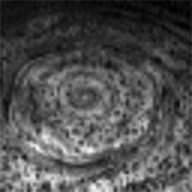Emily Lakdawalla • Nov 04, 2009
Planetary Radio Q and A: Saturn's Hexagon
Before I get to this week's Q and A, I should mention that the Carnival of Space can be found over at the Next Big Future.
This week's Planetary Radio features Lou Friedman on the Augustine Human Spaceflight report. On "Questions and Answers" I answered this question:
"How do they explain the hexagon near Saturn's north pole?"
Actually, the reader said more than that; they seemed to be under the bizarre impression that the Cassini team was hiding something about this odd feature of Saturn's atmosphere. Far from it; there's been quite a lot of published research on the topic. My answer was drawn from a few abstracts, including this one.
Saturn's north polar hexagon was discovered in Voyager images in 1980, and has been observed ever since. It's a long-lived, stable feature of Saturn's atmosphere, akin to Jupiter's Great Red Spot.
From the side, it looks like a wavy boundary between a light band of clouds and a dark band of clouds, located at seventy-six degrees north latitude. But if you compose a lot of images into a synthetic view looking down on Saturn's north pole, you'll notice there are exactly six up-and-down waves, so that the band of clouds appears like a hexagon centered on the pole.

Observations of Saturn in infrared wavelengths have shown that the hexagon is a deep feature, too, extending down to pressures of several bars. While it may be deep, it's not mysterious. Scientists have developed computer simulations of Saturn's atmosphere that contain a jet of wind at that latitude. With just a tiny bit of turbulence introduced into the simulation, the jet quickly develops a wavy motion. How long the waves are depends upon various characteristics of the atmosphere -- density, pressure, and so on -- but because Saturn is a globe, the waves meet themselves after journeying 360 degrees around the planet.
Under these circumstances, the waves naturally organize themselves into a standing wave, with an integer number of ups and downs. There's nothing special about the number six; if the jet were at a different latitude, Saturn might have wound up with a pentagon or a septagon. Cassini wasn't able to observe it in visible light until recently, because the north pole was in winter darkness when Cassini arrived. Now that spring has come to Saturn's north, we can look forward to terrific new images of the hexagon.
[The time constraints of radio did not allow me to clarify the last paragraph by noting that Cassini's infrared instruments can see Saturn by the thermal radiation emitted from its interior, so have been getting fantastic views of the hexagon and other atmospheric structures since Cassini arrived, including the animation I show above.]
Let’s Go Beyond The Horizon
Every success in space exploration is the result of the community of space enthusiasts, like you, who believe it is important. You can help usher in the next great era of space exploration with your gift today.
Donate Today

 Explore Worlds
Explore Worlds Find Life
Find Life Defend Earth
Defend Earth

